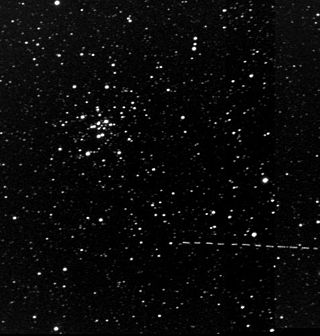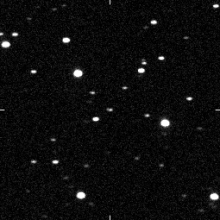(433953) 1997 XR2 is a sub-kilometer sized asteroid, classified as near-Earth object and potentially hazardous asteroid of the Apollo group. It was discovered on 4 December 1997, by the Lincoln Near-Earth Asteroid Research (LINEAR) program at Lincoln Laboratory's Experimental Test Site near Socorro, New Mexico, in the United States.
Piero Sicoli is an Italian astronomer and discoverer of minor planets, observing at the Italian Sormano Astronomical Observatory. As the observatory's coordinator, he is responsible for close encounters computation of near-Earth objects (NEOs), orbit computations, and identification of asteroids. The Observatory's focus is the examination and tracking of NEOs in Solar System.
Francesco Manca is an Italian amateur astronomer and discoverer of minor planets at the Sormano Astronomical Observatory in northern Italy.

(33342) 1998 WT24 is a bright, sub-kilometer asteroid, classified as near-Earth object and potentially hazardous asteroid (PHA) of the Aten group, located in Venus's zone of influence that has frequent close encounters with Mercury, Venus, and Earth. It made a close approach to Earth on 11 December 2015, passing at a distance of about 4.2 million kilometers (2.6 million miles, 11 lunar distances) and reaching about apparent magnitude 11.
99942 Apophis (provisional designation 2004 MN4) is a near-Earth asteroid and a potentially hazardous object with a diameter of 370 metres (1,210 feet) that caused a brief period of concern in December 2004 when initial observations indicated a probability up to 2.7% that it would hit Earth on April 13, 2029. Additional observations provided improved predictions that eliminated the possibility of an impact on Earth in 2029. Until 2006, a small possibility nevertheless remained that, during its 2029 close encounter with Earth, Apophis would pass through a gravitational keyhole of no more than about 800 kilometres (500 mi) in diameter, which would have set up a future impact exactly seven years later on April 13, 2036. This possibility kept it at Level 1 on the Torino impact hazard scale until August 2006, when the probability that Apophis would pass through the keyhole was determined to be very small and Apophis's rating on the Torino scale was lowered to zero. By 2008, the keyhole had been determined to be less than 1 km wide. During the short time when it had been of greatest concern, Apophis set the record for highest rating ever on the Torino scale, reaching level 4 on December 27, 2004.

A potentially hazardous object (PHO) is a near-Earth object – either an asteroid or a comet – with an orbit that can make close approaches to the Earth and which is large enough to cause significant regional damage in the event of impact. They are conventionally defined as having a minimum orbit intersection distance with Earth of less than 0.05 astronomical units and an absolute magnitude of 22 or brighter, the latter of which roughly corresponds to a size larger than 140 meters. More than 99% of the known potentially hazardous objects are no impact threat over the next 100 years. As of September 2022, just 17 of the known potentially hazardous objects listed on the Sentry Risk Table could not be excluded as potential threats over the next hundred years. Over hundreds if not thousands of years though, the orbits of some "potentially hazardous" asteroids can evolve to live up to their namesake.

Minimum orbit intersection distance (MOID) is a measure used in astronomy to assess potential close approaches and collision risks between astronomical objects. It is defined as the distance between the closest points of the osculating orbits of two bodies. Of greatest interest is the risk of a collision with Earth. Earth MOID is often listed on comet and asteroid databases such as the JPL Small-Body Database. MOID values are also defined with respect to other bodies as well: Jupiter MOID, Venus MOID and so on.
(101869) 1999 MM is a sub-kilometer asteroid on an eccentric orbit, classified as a near-Earth object and potentially hazardous asteroid of the Apollo group. It was discovered on 20 June 1999, by the Lowell Observatory Near-Earth-Object Search (LONEOS) at its U.S. Anderson Mesa Station in Flagstaff, Arizona. The first observation was made by Catalina Sky Survey just 8 days before its official discovery.
(85640) 1998 OX4 (provisional designation 1998 OX4) is a sub-kilometer asteroid, classified as near-Earth object and potentially hazardous asteroid of the Apollo group.
2003 BR47 is a sub-kilometer asteroid classified as near-Earth object and potentially hazardous asteroid of the Apollo group. It was discovered on 31 January 2003 by the LINEAR program. As of 19 March 2013, its orbit is based on 170 observations spanning a data-arc of 939 days.
2013 ND15 (also written 2013 ND15) is an asteroid that is a temporary trojan of Venus, the first known Venus trojan.
(456938) 2007 YV56, provisional designation 2007 YV56, is a sub-kilometer asteroid on an eccentric orbit, classified as a near-Earth object and potentially hazardous asteroid of the Apollo group, approximately 190–360 meters (620–1,200 ft) in diameter. It was discovered on 31 December 2007, by astronomers of the Catalina Sky Survey conducted at the Catalina Station in Arizona, United States.
2011 GA is a small asteroid that is a Near-Earth object and an Apollo asteroid.
(549948) 2011 WL2 is a sub-kilometer asteroid, classified as a near-Earth object and potentially hazardous asteroid of the Apollo group. It was discovered on 16 November 2011, by astronomers with the LINEAR at the Lincoln Laboratory ETS near Socorro, New Mexico, in the United States.
2001 AV43 is a very small, monolithic asteroid and fast rotator, classified as a near-Earth object of the Apollo group, approximately 30 meters (98 feet) in diameter. It was first observed on 5 January 2001, by astronomers of the LINEAR program at Lincoln Laboratory's Experimental Test Site near Socorro, New Mexico, in the United States. The presumed S-type asteroid has a rotation period of only 10 minutes. It has an exceptionally low MOID of 0.66 lunar distance (LD) and will approach Earth at 0.81 LD on 11 November 2029.
(415713) 1998 XX2 is a sub-kilometer asteroid, classified as a near-Earth object and potentially hazardous asteroid of the Aten group. It was discovered 8 December 1998, by the Lincoln Near-Earth Asteroid Research at Lincoln Laboratory's Experimental Test Site, and was found to have frequent approaches to the Earth, Venus, and Mercury.

(52768) 1998 OR2 (provisional designation 1998 OR2) is an asteroid on an eccentric orbit, classified as a near-Earth object and potentially hazardous asteroid of the Amor group, with a diameter of 2 kilometers (1.2 mi). It was discovered on 24 July 1998, by astronomers of the Near-Earth Asteroid Tracking (NEAT) program at the Haleakala Observatory, Hawaii. It is one of the brightest and therefore largest potentially hazardous asteroids known to exist. With an observation arc of 35 years, the asteroid has a well-determined orbit, and its trajectory is well known through the year 2197. The asteroid's orbit is only potentially hazardous on a time scale of thousands of years.
(85182) 1991 AQ is a stony asteroid on a highly eccentric orbit, classified as near-Earth object and potentially hazardous asteroid of the Apollo group, approximately 1.1 kilometers in diameter. It was discovered on 14 January 1991, by American astronomer Eleanor Helin at the Palomar Observatory in California. Based on its brightness variation of 0.69 magnitude, this Q-type asteroid is likely elongated. It belongs to the small group of potentially hazardous asteroids larger than one kilometer.
2019 PG1 is a sub-kilometer near-Earth object and potentially hazardous asteroid of the Apollo class, discovered by Pan-STARRS on 8 August 2019, two weeks after it passed Earth at 62 LD. With an observation arc of 103 days, Earth approach dates become divergent by 2042 as the date of closest approach in 2042 has an uncertainty of ±3 days.






